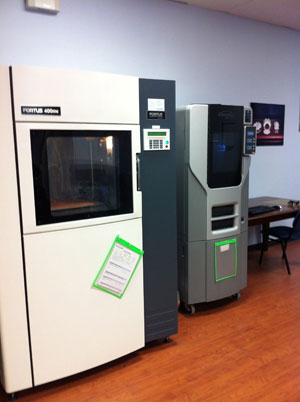Howard County wants to have a future in rapid manufacturing, and the next step in that process is the unveiling of 3D Maryland, introduced last week by Jan Baum, the former director of the Object Lab for digital fabrication at Towson University.
“We’re at the dawn of the new age of manufacturing and making,” she said before an audience of about 50 that included state elected officials and Howard County executive Ken Ulman. “It’s a brave new world, and we need to embrace it.”
As Technical.ly Baltimore first reported in October, 3D Maryland is an effort let by the county economic development group that could become a statewide initiative for broadening awareness of 3D printing — additive manufacturing, to use the technical jargon — and trying to formulate a way to make it more than something people do with desktop 3D printers. In other words, to shift the focus from the small-scale technology being promoted by such 3D-printer manufacturers as Brooklyn-based MakerBot to larger, production-type 3D printers used by Howard County-based UAV Solutions, which served as the backdrop for Friday morning’s 3D Maryland event.
UAV Solutions (the acronym stands for Unmanned Aerial Vehicles) started as a hybrid-manufacturing plant after its founding in 2006. Over time, the 3D printers employed by UAV for prototyping pieces of its winged machines became an integral part of the manufacturing process, as cofounder Bill Davidson explained.

From left: Howard County executive Ken Ulman, UAV Solutions CEO Bill Davidson, and Howard County councilwoman Courtney Watson examine one of the aerial vehicles UAV builds.
“You can do more with this technology than just build parts to look at,” he said, adding that “95 percent” of the UAVs the company now develops have at least one or two parts that are produced through 3D printing. A subsequent tour of UAV Solutions’ facilities revealed four large Fortus 400mc 3D printers, which a handful of UAV’s more than 50 employees use.
When Baum, who’s taking a two-year leave of absence from Towson to be the full-time director of 3D Maryland, speaks of a “brave new world” that needs “embracing,” she’s talking about using 3D printing to grow a new manufacturing class for a young century that has, through the promotion and promulgation of web- and mobile-focused tech startups, largely divorced people without the requisite skills from seizing better career opportunities and made middle men expendable.
Tinkering on desktop printers might be the necessary starting point for high school students just being introduced to the technology, but additive manufacturing — to take Baum’s hopes to their optimistic conclusion — means UAV employing more people to build machines (even if they are drones), or General Electric spending $3.5 billion to invest in 3D printers and triple the size of its 70-person 3D-printing staff over the next five years.
“This is not science fiction,” Baum said. “It is actually happening.”
To the 3D Maryland effort, Howard County has devoted roughly $500,000 of its budget, as well as about 2,000 square feet of space inside the Maryland Center for Entrepreneurship (MCE) as a way to “bring 3D manufacturers together” and “nurture the ecosystem,” county executive Ken Ulman said Friday.
Still, the 3D Maryland experiment remains in its opening stages. Julie Lenzer Kirk, director of the MCE, said a ribbon-cutting for the new 3D printing center within the MCE will be held in the spring, once walls are knocked down to make space and the necessary 3D printers have been purchased. Right now, Kirk said, there are three printers available at the MCE, including a MakerBot and a Dimension design series printer. (Dimension 3D printers are built by Stratasys, which savvily acquired MakerBot in August.)
Baum said she hopes to have four or five printers available at the Maryland Center for Entrepreneurship. Some will be desktop printers, but she also wants some production-type machines, which might mean a printer larger than the Fortus 400mc in use by UAV Solutions.
“We have not done a good job of positioning manufacturing in America,” Baum said Friday morning.
In Maryland, at least, it appears the tides are changing, one 3D-printed object at a time.
Join the conversation!
Find news, events, jobs and people who share your interests on Technical.ly's open community Slack

Baltimore daily roundup: Medtech made in Baltimore; Sen. Sanders visits Morgan State; Humane Ai review debate

Baltimore daily roundup: The city's new esports lab; a conference in Wilmington; GBC reports $4B of economic activity

Baltimore daily roundup: Find your next coworking space; sea turtle legislation; Dali raided and sued


